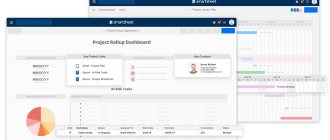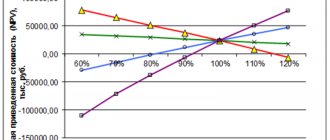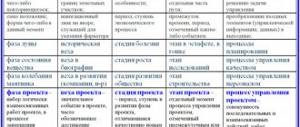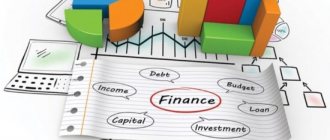A feasibility study (feasibility study) of a project is a set of documents in which calculations and comparisons of all financial indicators, features of the technical plan, mediocre and other indicators are carried out, helping to calculate the feasibility of the program.
The most important distinguishing feature of a feasibility study from a business plan is the individuality of the created calculation related to the construction and reconstruction of the business.
The production and technical features of developing a feasibility study for the plan leave the monetary component undisclosed. A business plan is based on the main points during development, not like a feasibility study. What follows from the above is that the business plan is designed for a narrower focus, based on the main aspects of the technical part in comparison with the business plan.
Feasibility studies are a way to conduct scientific and technical experiments that can make changes both in a certain research institute or pulp and paper mill, but also in the volumes of the entire state. The duty of engineers is to make correct calculations when constructing new production facilities, and to bring existing buildings to new standards. It is worth adding that not even a single event can be completed without a feasibility study, even minor modifications to a structure or serial assembly of equipment.
Purpose and objectives of the feasibility study of the project
The purpose of a feasibility study of a project is easy-to-understand information summarizing income in comparison with the money invested in establishing a new business or improving an existing one.
Researching and writing a feasibility study helps to trace the situation in an investment project and calculate all external and internal factors influencing the further existence of the investment project.
Also, drawing up a feasibility study is necessary for bank lending, since one copy of the document is submitted to the bank branch. A feasibility study may contain several calculations that will show significant changes in business growth, and solutions to unforeseen problems, to ensure the safety of the inverters' investment.
Thanks to a feasibility study of a business plan, you can see the pitfalls for people managing an enterprise and solve the following problems:
- choosing the most profitable plan;
- Buy a business plan
for obtaining additional financing from third-party investors; - increase in profitability (with a feasibility study for an operating enterprise).
Taking into account the above, a feasibility study of the project helps to identify the financial productivity of the plan, which describes the individuality of the investment project during the construction of the plant, and provides information for the investing or lending entity when calculating the applicant’s ability to implement the plan and pay the money. In this connection, the feasibility study becomes a fundamental pre-investment form that helps to convey to the customer, partner, the success of the project, relying on the technical and economic miscalculations of the plan.
Feasibility study for obtaining a bank loan
From time to time, companies need to raise additional funds to develop their business. In such a situation, entrepreneurs turn to the bank to obtain a loan. To ensure that the enterprise’s economy does not suffer, it is important to prove the feasibility of concluding lending agreements. To carry out a feasibility study, it is necessary to assess the company’s ability to repay loan funds. Calculations include:
- project completion date;
- Buy a business plan,
the amount of the monthly loan payment; - the company’s ability to make payments on debt without taking into account possible profits from the project;
- the amount of expected profit and its relationship with the amount of overpayments at the interest rate.
An example of a feasibility study for obtaining a bank loan.
Order the development of a feasibility study for the project
The development of a project feasibility study must be carried out by high-quality economists and engineers. A well-written feasibility study should contain research reports and calculations supported by documents. The document compiled should describe the idea and stages of the feasibility study; calculations of the profitability of the project in the current period of time, taking into account the characteristics of the market, are also appropriate.
The developed document will be a support when starting to implement the plan, as well as when searching for investors or creditors. Our company is an expert in this field, thanks to invaluable experience and regular customers. We are developing and providing the best services on the market. In our company, you can get a high-quality economic justification for the project. Which will help you correctly assess the return on investment and avoid mistakes.
Feasibility study of the feasibility of creating an enterprise
When creating a new company, it is important to prove that it will bring profit to the owners in the future. To do this, a document is created that describes in detail all the costs at the initial stage of work, as well as the time frame that the company needs to start making a profit. Unlike a business plan, this document does not prescribe the goals of opening an enterprise, but carries out economic calculations of the future efficiency of its operation. Thus, a description of the main costs and projected income helps to assess the feasibility of opening a company and investing in the project.
Structure of the feasibility study and its contents
For the correct execution and completion of the feasibility study, GOST standard 24.202−80 has been developed, unchanged since the existence of the USSR. In order for the justification to meet its standards, the content of the following blocks is necessary:
- Introduction.
- A comprehensive description of the project and the controls in place for it.
- Goal setting, evaluation standards and locality of the intended automated control system.
- Functional-target parts of the system.
- Expected technical and economic outcomes.
- Results and recommendations for the feasibility study.
The amount and nature of the information provided in the feasibility study depends on many factors, such as the scale of the project, its main goals, and the personal wishes of investors and managers. If necessary, it is allowed to add additional technical sections and subsections. All tips for filling them out are in the nature of recommendations and are not strict rules.
Feasibility study: introduction and summary
The document begins with a title. It should be concise and convey the main idea of the plan, giving potential investors an immediate idea of it. Next, there is an introduction to the feasibility study, which indicates the basic data about the work, among them there should be the following information:
- basis for development;
- the name of all organizations related to the project: the project customer, participants in the execution of work, sponsors;
- planned dates for the beginning and end of the practical implementation of the idea;
- financial data: sources of investment, amount of funds received, in what forms and in what order the financing will take place;
- a list of all documents and literature that served as primary sources for the analysis of information when writing the feasibility study.
The main task of this section of the feasibility study (TES) is to give the investor or customer a general impression of the project and form the correct idea. Document data should be presented as concisely and accurately as possible. Too much text and the lack of specific numbers in it can scare away potential partners.
Basic information about the feasibility study
Following the summary is the text of the feasibility study, which describes basic information about the project. It contains data such as the type of specialization of the enterprise, the planned volume of production and sales of products, probable profit, time frame for its receipt, analysis of investment efficiency and a list of all restrictions.
According to the example of a project feasibility study according to GOST, its basic section should include several categories. The first of these is a general characteristic. It contains the following data:
- features of the object that is planned to be built or created as a result of the implementation of the plan;
- information about the organization of all its issuing, regulatory and general economic structures;
- description of the elements of the object, from the point of view of organization, control and delegation, as well as the connectivity between their individual elements;
- listing with a brief announcement of management methods;
- known shortcomings of the applied management models of the facility;
- analysis of losses in the production process resulting from the impact of these shortcomings;
- readiness or unreadiness to implement automated control systems.
The purpose of this section is to describe the main idea of the plan and give the customer information about what result he will receive after its implementation. It should be followed by a description of the properties, scope and multi-phase goals of the project, which should include:
- all information about goal setting, description from technical, scientific, economic and production, as well as business points of view;
- a description of any restrictions in the implementation of the idea, which may be financial or technical, organizational or functional in nature.
The goals and assessments of this section are certain changes in the relevant indicators, and not a general description of the properties and capabilities of the planned object. To do this, there is a subsequent section in which you need to include:
- a list of all steps for the implementation of the planned object with the rationale for their selection and indication of the sequence of implementation;
- standards on quality, price and other technical and economic indicators for the implementation of tasks, a list of official documentation of a regulatory and normative nature;
- accompanying requirements both for the object as a whole and for its individual components, taking into account the specifics of the activity.
According to the state model of a project feasibility study, the next stage of its preparation is a description of the expected technical and financial results. It should include the following information:
- a list of all sources of financial benefits that will come as a result of the implementation of the feasibility study project - due to savings in the material and technical base, increasing quality without changing the price, and others;
- a description of the expected changes in the activity of the facility from the perspective of the dynamics of its technical, social and economic indicators after the implementation of the project;
- an assessment of the amount of all costs necessary to implement the plan with the distribution of costs by year;
- expected indicative indicators of economic efficiency.
In this section of the document, you need to calculate and write specific profitability indicators, such as IRR, NVP, net profit from a certain amount of investment and the period of its full payback.
This will help investors and lenders evaluate the project more accurately and increase confidence in it, which will increase the chances of cooperation. It is worth remembering that the feasibility study reflects only the idea and general plan of the project. The technical justification should not be filled with unnecessary details and contain a description of all the nuances of implementation - for this purpose a business plan is drawn up. The rationale is a relatively short and concise document designed primarily to interest funders rather than to actually act as a guide to action.
Different types of projects and features of justification for them
Depending on the goals of the undertaking, the calculations for them differ, sometimes quite significantly. Let's look at them in more detail:
- Investment . The most important thing is its profitability. Since finance is allocated by an investor who wants to make a profit as quickly as possible, a product that is already familiar on the market and has proven itself is often sold.
- Innovative . Since the production and launch of a new product or service on the market is proposed, the economic calculations are more carefully worked out. Particular attention is paid to possible risks and ways to minimize them. This kind of documents is more in demand by managers of existing enterprises who want to expand the range of products and conquer new markets.
- Construction . It is structured slightly differently. It is important to consider the availability and cost of a land plot, the expected capital intensity and the time it takes for production to reach its design capacity or the period for repayment of money when constructing a residential building.
Reconstruction . It is necessary to study in detail the issue regarding the need for such work and their main focus - changing spatial parameters (volume, area, number of floors), replacing worn-out structural elements with new ones. This also includes changing the category or class of linear objects (power grids, roads, gas pipelines).- Modernization . In its composition, the justification is similar to reconstruction, however, conclusions are drawn regarding the prospects of replacing fixed assets (mechanisms, equipment) with more modern and productive ones.
If the question concerns a large undertaking with the need for significant financial resources, then they use the services of specialized organizations that have experience in creating such documents and the necessary specialists. If the project is of an intra-company nature and is small in volume, then you can get by using your own financial and economic unit.
Basic information about the project
Depends on the specific project, may include sections:
— Types of activity of the enterprise / Types of products.
— Production capabilities and volumes.
Main activities
The main activities of the project enterprise are:
- development and production of new designs and equipment;
- engineering analysis;
- production of prototypes;
- rapid prototyping (creating samples to demonstrate or test feasibility);
- reverse engineering (creation of design documentation based on an existing physical model);
- production of industrial equipment (molds, dies).
All products are strictly individual and are made in accordance with the customer’s technical specifications.
Production capabilities
The project enterprise can be classified as a design and engineering production facility that produces unique products and equipment and is capable of rapid reorientation (within a month). The project involves the introduction of technological solutions based on the latest achievements in the field of design, rapid prototyping and casting using modern equipment from the world's leading manufacturers.
The project provides for the creation of several production areas:
- three-dimensional scanning, CAD/CAM engineering;
- rapid prototyping;
- precision casting area (plastics, metals);
- precision metalworking area (turning, milling);
- area for precision sheet metal processing.
- …










